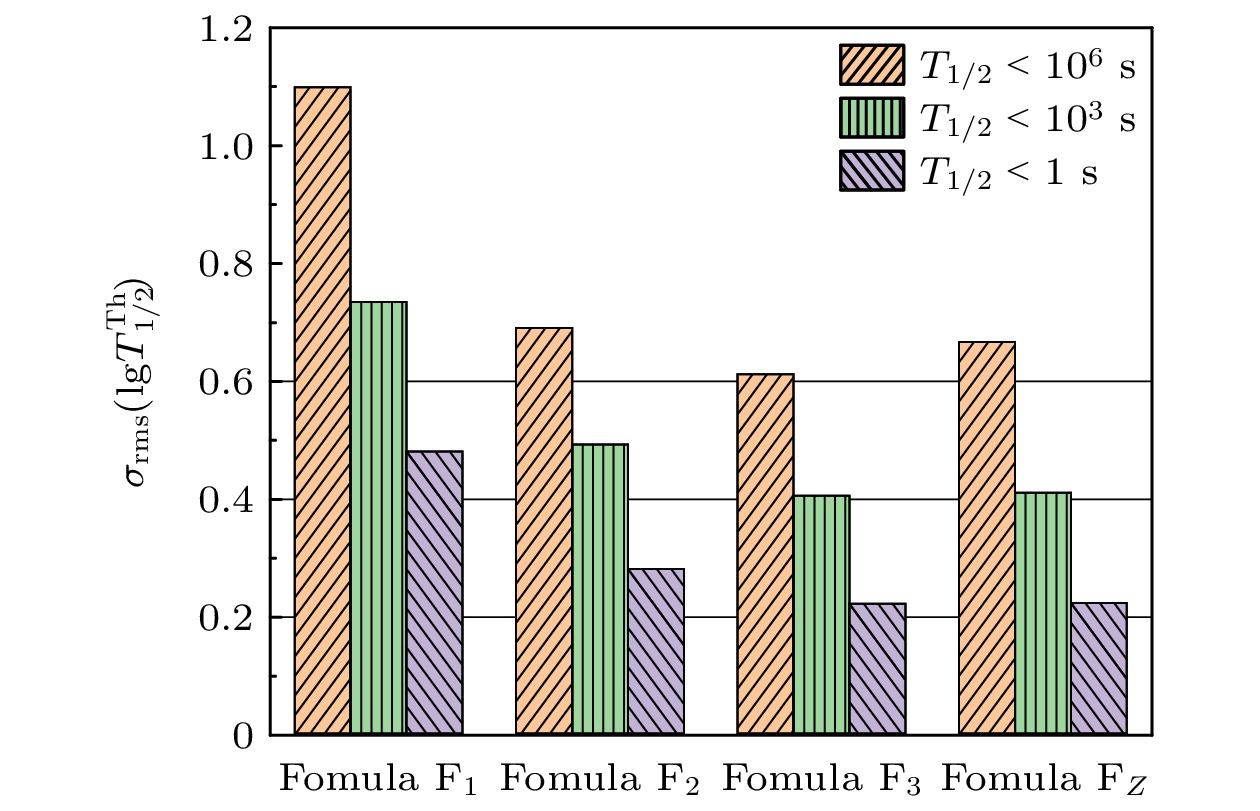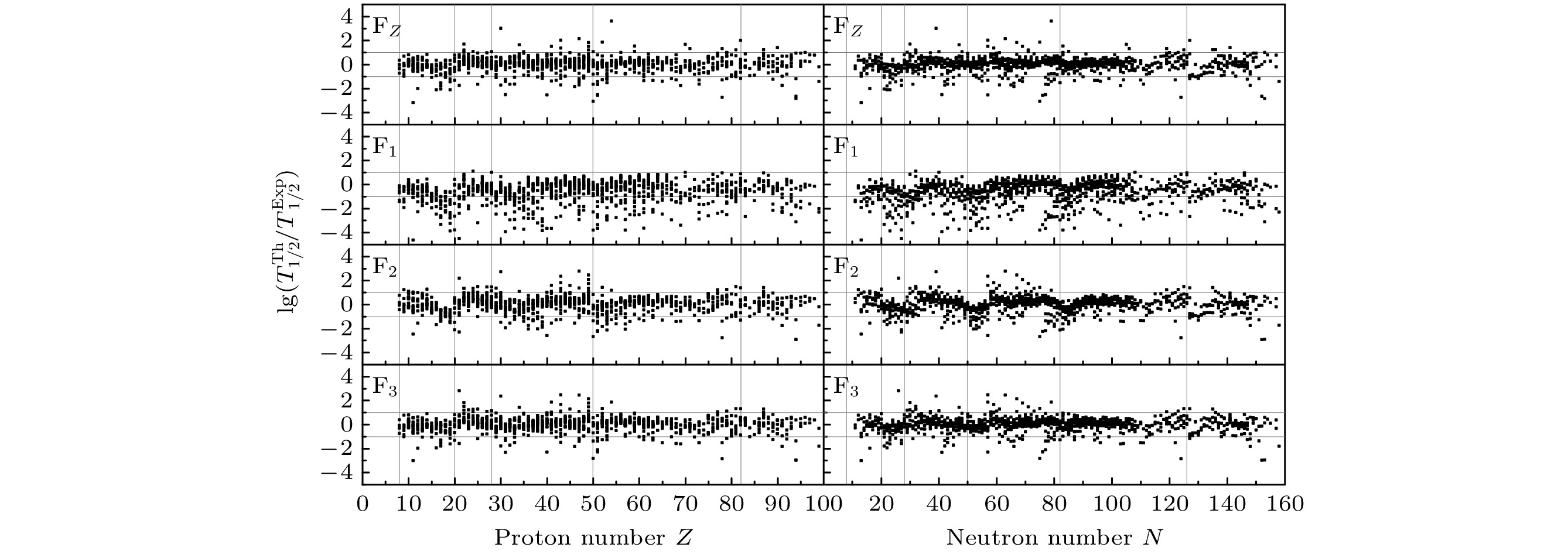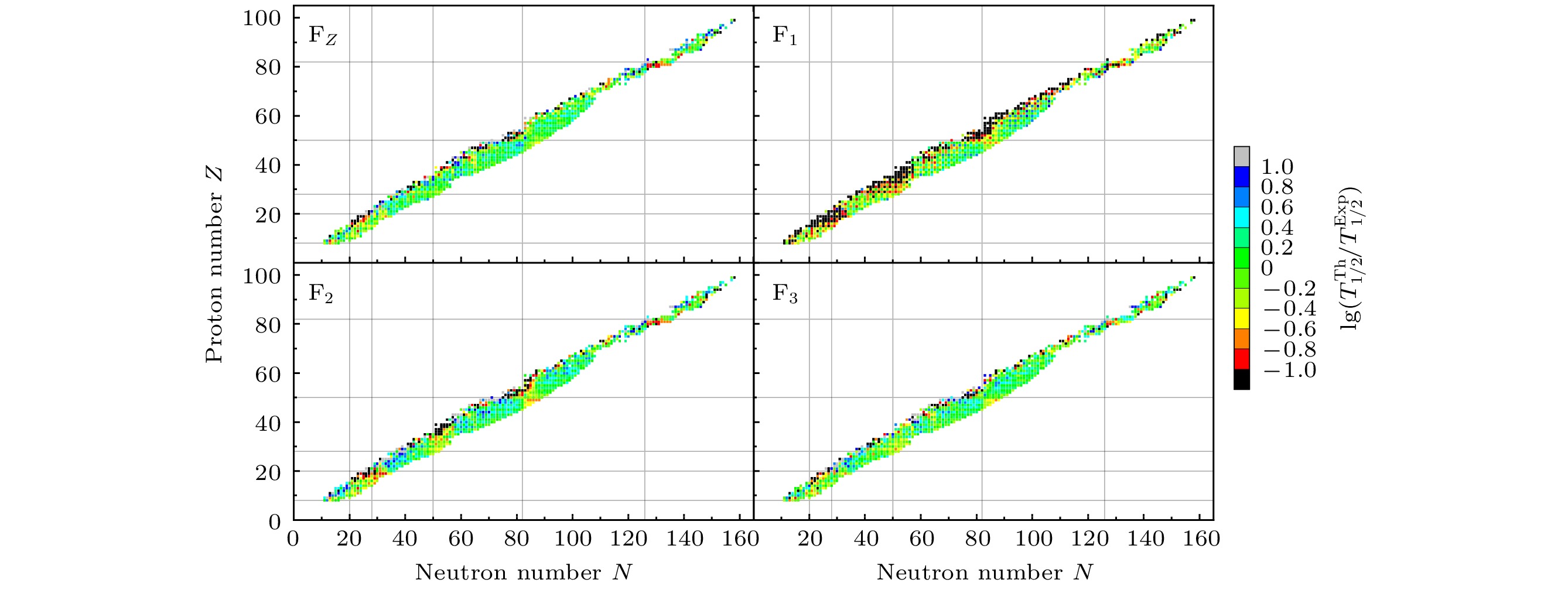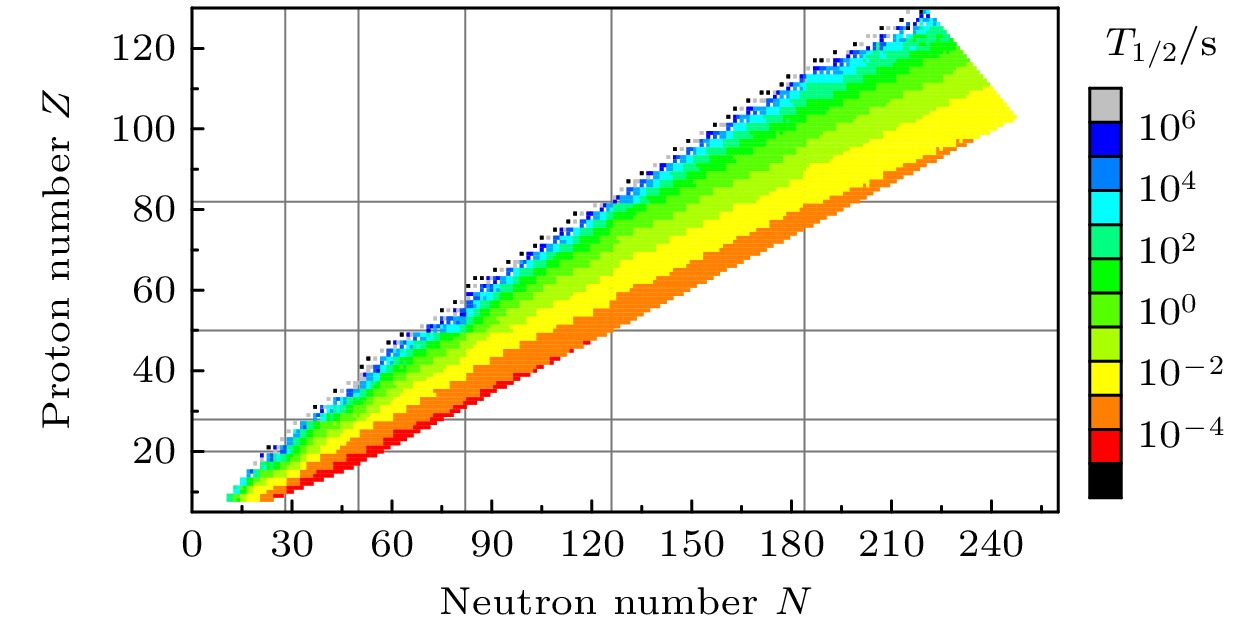-
基于β衰变的费米理论, 提出一个计算原子核β衰变寿命且不含自由参数的经验公式. 通过引入奇偶效应、壳效应以及同位旋依赖, 新提出的经验公式显著改进了对原子核β 衰变寿命的预言精度. 对于寿命小于1 s的原子核, 新经验公式的预言结果与实验寿命常用对数的均方根偏差降至0.220, 这比不含自由参数的经验公式提高约54%, 甚至优于目前已有的其他经验公式和微观的准粒子无规相位近似方法. 在未知核区, 新经验公式预言的轻核区原子核的β衰变寿命一般短于各微观模型的预言结果, 而其预言的重核区原子核的β衰变寿命与各微观模型预言结果基本一致. 进一步采用新经验公式预言了核素图上丰中子原子核的β衰变寿命, 为r - 过程的模拟提供了寿命输入.Nuclear β-decay half-lives play an important role not only in nuclear physics, but also in astrophysics. The β-decay half-lives of many nuclei involved in the astrophysical rapid neutron-capture (r -process) still cannot be measured experimentally, so the theoretical predictions of nuclear β-decay half-lives are inevitable for r-process studies. Theoretical models for studying the nuclear β-decay half-lives include the empirical formula, the gross theory, the quasiparticle random phase approximation (QRPA), and the shell model. Compared with other theoretical models of β-decay half-lives, the empirical formula has high computational efficiency, and its prediction accuracy can be improved by introducing more and more physical information. In this work, an empirical formula without free parameters is proposed to calculate the nuclear β-decay half-lives based on the Fermi theory of β decay. By including the pairing effect, the shell effect, and the isospin dependence, the newly proposed empirical formula significantly improves the accuracy of predicting the nuclear β-decay half-life. For the nuclei with half-lives less than 1 second, the root-mean-square deviation of the common logarithms of the nuclear β-decay half-life predicted by the new empirical formula from the experimental data decreases to 0.220, which is improved by about 54% compared with that by the empirical formula without free parameters, even better than those by other existing empirical formulas and microscopic QRPA approaches. In the unknown region, the nuclear β-decay half-lives predicted by the new empirical formula are generally shorter than those predicted by the microscopic models in the light nuclear region, while those predicted by the new empirical formula in the heavy nuclear region are generally in agreement with those predicted by the microscopic models. The half-lives of neutron-rich nuclei on the nuclear chart are then predicted by the new empirical formula, providing nuclear β-decay half-life inputs for the r-process simulations.
-
Keywords:
- β-decay half-lives /
- empirical formula /
- r-process
[1] Burbidge E M, Burbidge G R, Fowler W A, Hoyle F 1957 Rev. Mod. Phys. 29 547
 Google Scholar
Google Scholar
[2] Thielemann F K, Arcones A, Käappeli R, Liebendrfer M, Rauscher T, Winteler C, Fröhlichb C, Dillmannc I, Fischer T, Martinez-Pinedoc G, Langanke K, Farouqi K, Kratz K L, Panov I, Korneev I K 2011 Prog. Part. Nucl. Phys. 66 346
 Google Scholar
Google Scholar
[3] Cowan J J, Thielemann F K, Truran J W 1991 Phys. Rep. 208 267
 Google Scholar
Google Scholar
[4] Qian Y Z 2003 Prog. Part. Nucl. Phys. 50 153
 Google Scholar
Google Scholar
[5] Arnould M, Goriely S, Takahashi K 2007 Phys. Rep. 450 97
 Google Scholar
Google Scholar
[6] Chen J, Fang J Y, Hao Y W, Niu Z M, Niu Y F 2023 Astrophys. J. 943 102
 Google Scholar
Google Scholar
[7] Mumpower M R, Surmana R, McLaughlin G C, Aprahamian A 2016 Prog. Part. Nucl. Phys. 86 86
 Google Scholar
Google Scholar
[8] Li Z, Niu Z M, Sun B H 2019 Sci. China. Phys. Mech. Astron. 62 982011
 Google Scholar
Google Scholar
[9] Niu Z, Sun B, Meng J 2009 Phys. Rev. C 80 065806
 Google Scholar
Google Scholar
[10] Surman R, Engel J, Bennett J R, Meyer B S 1997 Phys. Rev. Lett. 79 1809
 Google Scholar
Google Scholar
[11] Zhang X P, Ren Z Z 2006 Phys. Rev. C 73 014305
 Google Scholar
Google Scholar
[12] Zhang X P, Ren Z Z, Zhi Q J, Zheng Q 2007 J. Phys. G: Nucl. Part. Phys. 34 2611
 Google Scholar
Google Scholar
[13] Zhou Y, Li Z H, Wang Y B, Chen Y S, Guo B, Su J, Li Y J, Yan S Q, Li X Y, Han Z Y, Shen Y P, Gan L, Zeng S, Lian G, Liu W P 2017 Sci. China-Phys. Mech. Astron. 60 082012
 Google Scholar
Google Scholar
[14] Takahashi K, Yamada M 1969 Prog. Theor. Phys. 41 1470
 Google Scholar
Google Scholar
[15] Tachibana T, Yamada M, Yoshida Y 1990 Prog. Theor. Phys. 84 641
 Google Scholar
Google Scholar
[16] Nakata H, Tachibana T, Yamada M 1997 Nucl. Phys. A 625 521
 Google Scholar
Google Scholar
[17] Koura H, Chiba S 2017 Phys. Rev. C 95 064304
 Google Scholar
Google Scholar
[18] Engel J, Bender M, Dobaczewski J, Surman R 1999 Phys. Rev. C 60 014302
 Google Scholar
Google Scholar
[19] Minato F, Bai C L 2013 Phys. Rev. Lett. 110 122501
 Google Scholar
Google Scholar
[20] Niu Z M, Niu Y F, Liang H Z, Long W H, Nikšić T, Vretenar D, Meng J 2013 Phys. Lett. B 723 172
 Google Scholar
Google Scholar
[21] Borzov I N, Goriely S 2000 Phys. Rev. C 62 035501
 Google Scholar
Google Scholar
[22] Langanke K, Martínez-Pinedo G 2003 Rev. Mod. Phys. 75 819
 Google Scholar
Google Scholar
[23] Martínez-Pinedo G, Langanke K 1999 Phys. Rev. Lett. 83 4502
 Google Scholar
Google Scholar
[24] Suzuki T, Yoshida T, Kajino T, Otsuka T 2012 Phys. Rev. C 85 015802
 Google Scholar
Google Scholar
[25] Zhi Q, Caurier E, Cuenca-García J J, Langanke K, Martínez-Pinedo G, Sieja K 2013 Phys. Rev. C 87 025803
 Google Scholar
Google Scholar
[26] Möller P, Pfeiffer B, Kratz K L 2003 Phys. Rev. C 67 055802
 Google Scholar
Google Scholar
[27] Minato F, Niu Z, Liang H 2022 Phys. Rev. C 106 024306
 Google Scholar
Google Scholar
[28] Marketin T, Huther L, Martinez-Pinedo G 2016 Phys. Rev. C 93 025805
 Google Scholar
Google Scholar
[29] Niu Z M, Niu Y F, Liu Q, Liang H Z, Guo J Y 2013 Phys. Rev. C 87 051303
 Google Scholar
Google Scholar
[30] Wang Z Y, Niu Y F, Niu Z M, Guo J Y 2016 J. Phys. G: Nucl. Part. Phys. 43 045108
 Google Scholar
Google Scholar
[31] Nakatsukasa T, Inakura T, Yabana K 2007 Phys. Rev. C 76 024318
 Google Scholar
Google Scholar
[32] Liang H Z, Nakatsukasa T, Niu Z M, Meng J 2013 Phys. Rev. C 87 054310
 Google Scholar
Google Scholar
[33] Ney E M, Engel J, Li T, Schunck N 2020 Phys. Rev. C 102 034326
 Google Scholar
Google Scholar
[34] Mustonen M T, Engel J 2016 Phys. Rev. C 93 014304
 Google Scholar
Google Scholar
[35] Endo F, Koura H 2019 Phys. Rev. C 99 034303
 Google Scholar
Google Scholar
[36] Fang J Y, Chen J, Niu Z M 2022 Phys. Rev. C 106 054318
 Google Scholar
Google Scholar
[37] Sargent B W 1933 Proc. R. Soc. Lond. A 139 659
 Google Scholar
Google Scholar
[38] Shi M, Fang J Y, Niu Z M 2021 Chin. Phys. C 45 044103
 Google Scholar
Google Scholar
[39] Uyen N K, Chae K Y, Duy N N, Ly N D 2022 J. Phys. G: Nucl. Part. Phys. 49 025201
 Google Scholar
Google Scholar
[40] Kondev F G, Wang M, Huang W J, Naimi S, Audi G 2021 Chin. Phys. C 45 030001
 Google Scholar
Google Scholar
[41] Fermi E 1934 Z. Phys. 88 161
 Google Scholar
Google Scholar
[42] Wang N, Liu M, Wu X, Meng J 2014 Phys. Lett. B 734 215
 Google Scholar
Google Scholar
[43] Möller P, Mumpower M R, Kawano T, Myers W D 2019 At. Data Nucl. Data Tables 125 1
 Google Scholar
Google Scholar
-
图 2 经验公式${\rm F}_1$, ${\rm F}_2$, ${\rm F}_3$, ${\rm F}_Z$的预测结果与实验数据的对数差随质子数Z和中子数N的变化. 竖线对应质子幻数$ Z=8, $$ 20, 28, 50, 82 $和中子幻数$ N=8, 20, 28, 50, 82, 126 $
Fig. 2. Logarithmic differences between the predictions by the empirical formulas ${\rm F}_1$, ${\rm F}_2$, ${\rm F}_3$, ${\rm F}_Z$ and the experimental data as the functions of proton number Z and neutron number N. The vertical lines correspond to the proton magic numbers $ Z=8, 20, 28, 50, 82 $ and the neutron magic numbers $ N=8, 20, 28, 50, 82, 126 $
图 6 公式${\rm F}_3$预测的Zn, Zr, Sn, Nd, Pb同位素的$\beta$衰变寿命, 及其与FRDM + QRPA, HFB + FAM, HFB + QRPA理论结果的比较
Fig. 6. Nuclear $\beta$-decay half-lives of Zn, Zr, Sn, Nd and Pb isotopes predicted by formula ${\rm F}_3$, and the comparison with the theoretical results of FRDM + QRPA, HFB + FAM and HFB + QRPA models
表 1 经验公式${\rm F}_1$, ${\rm F}_2$, ${\rm F}_3$和${\rm F}_Z$预言的原子核衰变寿命的对数与实验数据的均方根偏差$\sigma_{\rm{rms}}(\lg T_{1/2})$, 其中第2—4列分别对应$T_{1/2}< 10^6\ {\rm{s}}$, $T_{1/2}< 10^3\ {\rm{s}}$和$T_{1/2}< 1\ {\rm{s}}$的原子核数据集
Table 1. The rms deviations $\sigma_{\rm{rms}}(\lg T_{1/2})$ of the logarithms of nuclear $\beta$-decay half-lives predicted by the empirical formulas ${\rm F}_1$, ${\rm F}_2$, ${\rm F}_3$, and ${\rm F}_Z$ with respective to the experimental data, where the 2nd–4th columns represent the data sets for nuclei with $T_{1/2}< 10^6\ {\rm{s}}$, $T_{1/2}< 10^3\ {\rm{s}}$, and $T_{1/2}< 1\ {\rm{s}}$, respectively
Formula $ T_{1/2}< {10^6 \; {\rm{s}}}$ $T_{1/2}< {10^3 \; {\rm{s}}}$ $T_{1/2}< {1 \; {\rm{s}}}$ ${\rm F}_1$ 1.096 0.732 0.478 ${\rm F}_2$ 0.688 0.490 0.279 ${\rm F}_3$ 0.609 0.403 0.220 ${\rm F}_Z$ 0.664 0.408 0.221 -
[1] Burbidge E M, Burbidge G R, Fowler W A, Hoyle F 1957 Rev. Mod. Phys. 29 547
 Google Scholar
Google Scholar
[2] Thielemann F K, Arcones A, Käappeli R, Liebendrfer M, Rauscher T, Winteler C, Fröhlichb C, Dillmannc I, Fischer T, Martinez-Pinedoc G, Langanke K, Farouqi K, Kratz K L, Panov I, Korneev I K 2011 Prog. Part. Nucl. Phys. 66 346
 Google Scholar
Google Scholar
[3] Cowan J J, Thielemann F K, Truran J W 1991 Phys. Rep. 208 267
 Google Scholar
Google Scholar
[4] Qian Y Z 2003 Prog. Part. Nucl. Phys. 50 153
 Google Scholar
Google Scholar
[5] Arnould M, Goriely S, Takahashi K 2007 Phys. Rep. 450 97
 Google Scholar
Google Scholar
[6] Chen J, Fang J Y, Hao Y W, Niu Z M, Niu Y F 2023 Astrophys. J. 943 102
 Google Scholar
Google Scholar
[7] Mumpower M R, Surmana R, McLaughlin G C, Aprahamian A 2016 Prog. Part. Nucl. Phys. 86 86
 Google Scholar
Google Scholar
[8] Li Z, Niu Z M, Sun B H 2019 Sci. China. Phys. Mech. Astron. 62 982011
 Google Scholar
Google Scholar
[9] Niu Z, Sun B, Meng J 2009 Phys. Rev. C 80 065806
 Google Scholar
Google Scholar
[10] Surman R, Engel J, Bennett J R, Meyer B S 1997 Phys. Rev. Lett. 79 1809
 Google Scholar
Google Scholar
[11] Zhang X P, Ren Z Z 2006 Phys. Rev. C 73 014305
 Google Scholar
Google Scholar
[12] Zhang X P, Ren Z Z, Zhi Q J, Zheng Q 2007 J. Phys. G: Nucl. Part. Phys. 34 2611
 Google Scholar
Google Scholar
[13] Zhou Y, Li Z H, Wang Y B, Chen Y S, Guo B, Su J, Li Y J, Yan S Q, Li X Y, Han Z Y, Shen Y P, Gan L, Zeng S, Lian G, Liu W P 2017 Sci. China-Phys. Mech. Astron. 60 082012
 Google Scholar
Google Scholar
[14] Takahashi K, Yamada M 1969 Prog. Theor. Phys. 41 1470
 Google Scholar
Google Scholar
[15] Tachibana T, Yamada M, Yoshida Y 1990 Prog. Theor. Phys. 84 641
 Google Scholar
Google Scholar
[16] Nakata H, Tachibana T, Yamada M 1997 Nucl. Phys. A 625 521
 Google Scholar
Google Scholar
[17] Koura H, Chiba S 2017 Phys. Rev. C 95 064304
 Google Scholar
Google Scholar
[18] Engel J, Bender M, Dobaczewski J, Surman R 1999 Phys. Rev. C 60 014302
 Google Scholar
Google Scholar
[19] Minato F, Bai C L 2013 Phys. Rev. Lett. 110 122501
 Google Scholar
Google Scholar
[20] Niu Z M, Niu Y F, Liang H Z, Long W H, Nikšić T, Vretenar D, Meng J 2013 Phys. Lett. B 723 172
 Google Scholar
Google Scholar
[21] Borzov I N, Goriely S 2000 Phys. Rev. C 62 035501
 Google Scholar
Google Scholar
[22] Langanke K, Martínez-Pinedo G 2003 Rev. Mod. Phys. 75 819
 Google Scholar
Google Scholar
[23] Martínez-Pinedo G, Langanke K 1999 Phys. Rev. Lett. 83 4502
 Google Scholar
Google Scholar
[24] Suzuki T, Yoshida T, Kajino T, Otsuka T 2012 Phys. Rev. C 85 015802
 Google Scholar
Google Scholar
[25] Zhi Q, Caurier E, Cuenca-García J J, Langanke K, Martínez-Pinedo G, Sieja K 2013 Phys. Rev. C 87 025803
 Google Scholar
Google Scholar
[26] Möller P, Pfeiffer B, Kratz K L 2003 Phys. Rev. C 67 055802
 Google Scholar
Google Scholar
[27] Minato F, Niu Z, Liang H 2022 Phys. Rev. C 106 024306
 Google Scholar
Google Scholar
[28] Marketin T, Huther L, Martinez-Pinedo G 2016 Phys. Rev. C 93 025805
 Google Scholar
Google Scholar
[29] Niu Z M, Niu Y F, Liu Q, Liang H Z, Guo J Y 2013 Phys. Rev. C 87 051303
 Google Scholar
Google Scholar
[30] Wang Z Y, Niu Y F, Niu Z M, Guo J Y 2016 J. Phys. G: Nucl. Part. Phys. 43 045108
 Google Scholar
Google Scholar
[31] Nakatsukasa T, Inakura T, Yabana K 2007 Phys. Rev. C 76 024318
 Google Scholar
Google Scholar
[32] Liang H Z, Nakatsukasa T, Niu Z M, Meng J 2013 Phys. Rev. C 87 054310
 Google Scholar
Google Scholar
[33] Ney E M, Engel J, Li T, Schunck N 2020 Phys. Rev. C 102 034326
 Google Scholar
Google Scholar
[34] Mustonen M T, Engel J 2016 Phys. Rev. C 93 014304
 Google Scholar
Google Scholar
[35] Endo F, Koura H 2019 Phys. Rev. C 99 034303
 Google Scholar
Google Scholar
[36] Fang J Y, Chen J, Niu Z M 2022 Phys. Rev. C 106 054318
 Google Scholar
Google Scholar
[37] Sargent B W 1933 Proc. R. Soc. Lond. A 139 659
 Google Scholar
Google Scholar
[38] Shi M, Fang J Y, Niu Z M 2021 Chin. Phys. C 45 044103
 Google Scholar
Google Scholar
[39] Uyen N K, Chae K Y, Duy N N, Ly N D 2022 J. Phys. G: Nucl. Part. Phys. 49 025201
 Google Scholar
Google Scholar
[40] Kondev F G, Wang M, Huang W J, Naimi S, Audi G 2021 Chin. Phys. C 45 030001
 Google Scholar
Google Scholar
[41] Fermi E 1934 Z. Phys. 88 161
 Google Scholar
Google Scholar
[42] Wang N, Liu M, Wu X, Meng J 2014 Phys. Lett. B 734 215
 Google Scholar
Google Scholar
[43] Möller P, Mumpower M R, Kawano T, Myers W D 2019 At. Data Nucl. Data Tables 125 1
 Google Scholar
Google Scholar
计量
- 文章访问数: 6492
- PDF下载量: 150
- 被引次数: 0














 下载:
下载:






